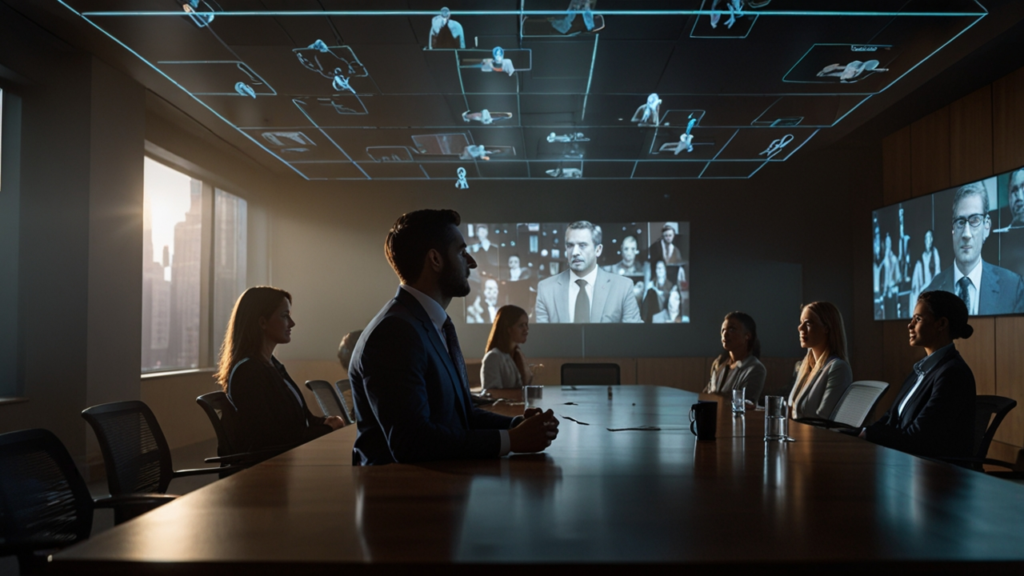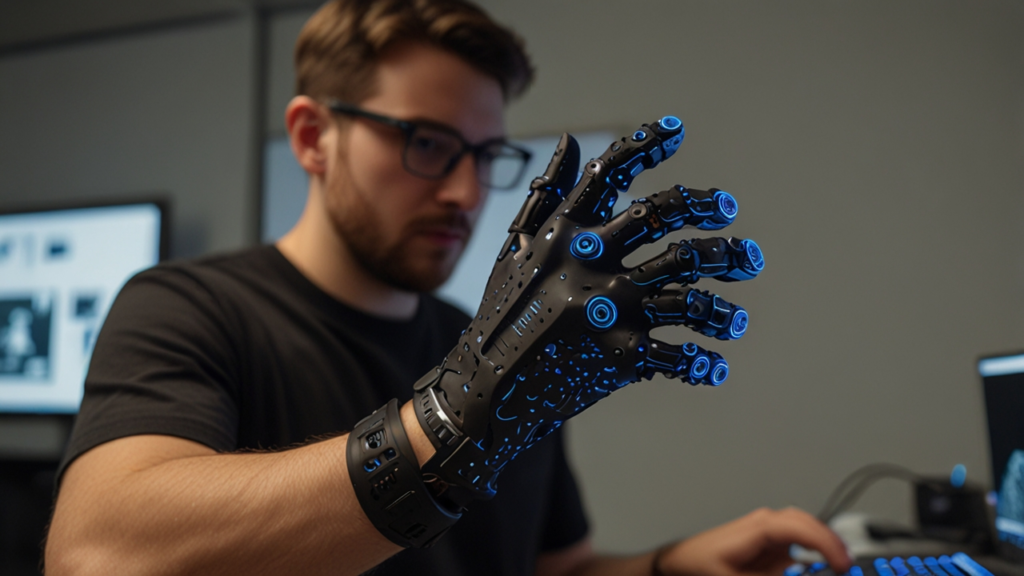Hologram Communication Future 2025
Welcome to an in‐depth look into the future of holographic technologies, where imagination meets science and innovation. In this article, we will explore how emerging breakthroughs and historical milestones have shaped and continue to influence this rapidly evolving field. Our journey will take you from the early dreams of science-fiction to cutting‐edge interactive systems.
The world of holographic communication has seen remarkable changes over decades. With milestones that once belonged in the realm of fantasy now stepping into reality, the evolution is nothing short of inspiring. You will discover how technology is building bridges between virtual and real interactions.
We invite you to join the conversation, share your thoughts, and learn more about the transformative potential of this technology. For more information about innovative trends in this domain, check out the Mobile & Gadgets section.
Table of Contents
- Introduction to Hologram Communication
- Evolution and History of Hologram Communication
- How 3D Telepresence Enhances Hologram Communication
- Volumetric Display Systems and Their Applications
- Real-World Case Studies of Hologram Communication
- Spatial Interaction in Modern Hologram Communication Solutions
- Future Trends: Virtual Presence and Beyond
Introduction to Hologram Communication
Discover the basics of this transformative technology with insights from Cutting-Edge Technologies.
Defining the Technology
Hologram Communication is an emerging technology that allows information and images to be transmitted as three-dimensional projections. This innovative method goes beyond traditional displays by offering a lifelike visual presence, often incorporating elements that once could only be imagined. In defining the technology, researchers have explored both optical and computational holography. Early versions used lasers and static techniques, but modern advancements employ digital projection and rapid image sequencing to create continuous 3D visuals. For example, studies have documented systems that project more than 2,800 images per second to generate seamless animations. These advancements have led to interactive systems that enable users to manipulate images directly, bridging the gap between virtual and physical objects. Numerous research papers and industry reports, such as a detailed study on holographic systems available on Wikipedia, support these innovations. Have you ever experienced technology that makes you feel like you’re stepping into another world?
Key Concepts in 3D Visualization
The core ideas behind this technology involve complex optics and digital algorithms that collaborate to present 3D visualizations. Researchers articulate that the process relies on principles such as light coherence, interference, and diffraction combined with computational power. In this context, a key metric observed in research was that systems projecting 2,880 images per second on specialized diffusers have shown impressive steadiness and continuity. The interaction is hence not only about static images but also dynamic, real-time visual experiences. Moreover, the technology has built upon conventional optical holography to incorporate digital techniques that accommodate rapid image updates. This evolution has led to the development of devices that can be used both in educational settings and interactive displays. The integration of these concepts has already begun re-shaping industries, thanks to both academic and commercial research. Does this breakthrough spark your curiosity about how advanced imaging transforms everyday experiences?
Evolution and History of Hologram Communication
Learn about historical innovations with insights from Future Devices.
Science Fiction to Scientific Reality
The journey from science fiction to scientific fact is one of the most fascinating aspects of holographic technology. What started as a dream in popular culture, featuring scenes like Princess Leia’s iconic message in Star Wars, laid the imagination’s groundwork for future research. In the 20th century, researchers experimented with laser-based optical holography—techniques that allowed static 3D images to be recorded and viewed under specific conditions. Over time, the field progressed significantly, incorporating advancements in computing, sensor technologies, and display systems. Data from a 2019 study demonstrated that breakthroughs in head-mounted VR/AR systems led to unprecedented resolution enhancements and realism. This evolution, driven both by European funding and Asian technological investments, signifies a critical transition from novelty to pragmatic applications. Do you feel inspired by the way fiction has shaped scientific inquiry?
Milestone Developments in the Field
Key milestones in the history of this field are well documented. For instance, in the 2020s, European Union-funded research projects contributed significantly by exploring touch-based interactive systems. Parallel to these efforts, research teams in Asia, particularly in Japan and South Korea, integrated high-resolution spatial light modulators into VR environments, pushing forward the limits of what can be achieved. A notable case was the development of interactive systems using elastic diffusers, which replaced rigid components to enable safe hand interactions. This breakthrough has led to systems that offer improved accuracy and user confidence. External reports, such as those detailed on Wikipedia, confirm these findings through extensive case studies and user tests. How do you think these historical milestones impact current innovations?
How 3D Telepresence Enhances Hologram Communication
Explore interactive futuristic applications with insights from Smart Devices.
Integration with Telepresence Solutions
Combining telepresence with holographic systems has opened new dimensions in remote interactions. Integrating real-time 3D projection with communication systems, early prototypes of telepresence allowed distant individuals to be represented as life-size holograms. This means that the remote party can participate almost as if physically present. For instance, a demonstrative project showcased by researchers achieved life-size projections that helped bridge physical distance. Although still in the prototype stage for many applications, this integration has promising implications for business meetings and remote collaboration. Detailed observations from conferences like CHI 2025 have shown that such systems offer improved task completion time and greater user confidence by up to 94% compared to traditional 3D mouse interactions. Can you imagine using such technology in your everyday work or study?
Impact on Remote Interactions and Communication
The impact of combining telepresence with holographic communication is profound. As these systems mature, they have the potential to transform academic, corporate, and personal communications. Data indicates that the extended reality provided by life-size projections enhances engagement and provides a more intuitive experience than flat screens. Innovative prototypes have been tested in various environments, including educational institutions and healthcare settings, offering clear benefits in terms of speed, accuracy, and overall communication efficiency. Reports published by Virtual On Group show that these technologies help reduce miscommunication and encourage collaborative problem-solving. What innovations in remote communication could most benefit your professional or personal life?
Volumetric Display Systems and Their Applications
Discover breakthrough display tech insights with Innovative Solutions.
Innovations in Volumetric Technology
Volumetric display systems represent one of the most significant advancements in visual technology. These systems deploy techniques such as swept-volume displays, where rapidly oscillating diffusers project images at varying heights. A landmark innovation – FlexiVol, developed by a Spanish team at the Public University of Navarra – replaces traditional rigid diffusers with an elastic material. This allows users to interact safely with mid-air images. The system can project up to 2,880 images per second, providing a remarkably smooth visual experience. Studies have indicated that such systems increase task accuracy by 67% over conventional 3D mice. Detailed technical specifications and performance metrics are available from sources like New Atlas. How might these volumetric innovations change daily life in entertainment and education?
Real-World Applications of Volumetric Displays
The application of volumetric display systems is widespread, impacting various industries. These include museum exhibits, interactive educational platforms, and retail experiences where dynamic visualization captures the audience’s attention. For instance, the VX2 system by Voxon Photonics is already used in exhibitions and public installations to deliver immersive, 360-degree experiences. Such products provide a shared view of holographic images without the need for special glasses, fostering collaborative interactions among users. In addition, research from Asia has focused on adapting these systems for use in medical imaging, providing clear, detailed models that support diagnostic procedures and surgical planning. These applications not only enhance user experience but also increase operational efficiency. How do you see these applications influencing future public installations or learning environments?
Real-World Case Studies of Hologram Communication
Gain practical insights from real deployments by checking out Future Technologies.
Case Study: FlexiVol in Spain
One of the most groundbreaking examples in recent years is the FlexiVol system developed by a Spanish research team at the Public University of Navarra in 2025. This innovative system allows users to interact directly with holographic images using free-hand manipulations. According to user studies involving 18 participants, 94% felt more confident when completing tasks with this system compared to a conventional 3D mouse, and task accuracy improved by 67%. The FlexiVol projection, achieved by replacing rigid projection diffusers with an elastic diffusing material, enables safe and intuitive mid-air interactions. Such precision has attracted global attention, with industry giants like Microsoft, Meta, and Apple reportedly showing interest. For detailed technical insights, refer to resources provided by ISPR. Have you ever encountered a system that so effortlessly merges digital and physical interactions?
Case Study: Voxon VX2 in Australia and Asian Innovations
In Australia, Voxon Photonics has successfully commercialized volumetric display technology with its VX2 system. This product is utilized in museums, educational institutions, and for interactive public exhibits. The VX2 offers a real-time, 360-degree holographic experience which does not require special eyewear, making it accessible and engaging. Additionally, in Asia, particularly in regions like Japan and South Korea, labs and tech giants are experimenting with high-resolution head-mounted displays aiming to merge VR/AR functionalities with telepresence. These experiments are part of a broader trend to harness holographic communication for remote diagnostics and telemedicine. External documentation, including a dynamic demonstration video on YouTube, showcases the interactive capabilities of these systems. What potential benefits do you envision from these real-world implementations?
Spatial Interaction in Modern Hologram Communication Solutions
For integration insights, explore emerging trends at Cutting-Edge Technologies.
Advances in Direct Hand Manipulation
Recent advancements in direct hand manipulation have revolutionized how users interact with holographic systems. The introduction of elastic diffusers enables safe, intuitive, and immersive interactions, allowing users to physically touch and manipulate virtual objects. Research shows that such systems have led to a significant reduction in task completion times and error rates. For instance, laboratory studies have verified improvements in both speed and precision compared to using traditional interface devices like 3D mice. This kind of spatial interaction is at the core of next-generation interfaces where natural gestures replace buttons and controllers. In projects where users could directly engage with floating holograms, the overall effectiveness of the system was notably enhanced. Such findings are backed by extensive documentation available in reports like those on Innovations Report. How might these tangible interactions change your day-to-day digital experiences?
Gesture and Spatial Interaction Techniques
Alongside direct hand manipulation, gesture recognition serves as another pillar of spatial interaction. While traditional systems rely on cameras and sensors that capture gesture data, recent developments have focused on combining these with tactile feedback from elastic diffusers. This dual approach not only improves responsiveness but also enhances user satisfaction by simulating real tactile interactions. Studies indicate that even minor improvements in gesture accuracy can lead to large gains in usability and trust in the technology. Research has demonstrated that the combination of sensor-based gesture analysis with direct physical input creates a more immersive experience for users. Additionally, findings suggest that users preferred these hybrid methods, especially when interacting with complex virtual environments. As the technology evolves, the interplay between sensor data and physical feedback is expected to become more refined. How do you think enhanced gesture controls could further personalize your interactions with digital systems?
Future Trends: Virtual Presence and Beyond
Discover future visions with insights from Future Technologies.
Emerging Trends in Virtual Presence
The future of holographic systems points toward a more immersive virtual presence that transcends current limitations. Although full-room holograms as seen in science fiction remain aspirational, incremental improvements are evident in several emerging technologies. Developers are focusing on increasing resolution, reducing latency, and making systems more affordable. For example, early prototypes of life-size telepresence systems have shown promising improvements in rendering lifelike images that can be viewed from any angle. Research indicates that such systems could have a profound impact on business communications and remote healthcare. Studies on advanced systems using high-resolution spatial light modulators have demonstrated dramatically improved user experiences and engagement levels. External analyses, such as those on Daily Galaxy, illustrate the journey from prototype to potential mass-market products. Do you believe these trends will change the way we interact with digital content in the coming years?
Anticipated Developments and Global Impact
Looking ahead, global collaboration holds the key to overcoming technical challenges such as scalability, resolution, and cost. Future developments are expected to combine innovations from Europe, Australia, and Asia, creating hybrid systems that benefit from the strengths of each region. Governments and private entities alike are investing in research and development to optimize existing technologies for mass adoption. With continued improvement in both hardware and software, these systems are poised to redefine various sectors including education, entertainment, and healthcare. Notably, increasing accessibility could democratize the use of advanced holographic systems, making them available in everyday contexts. As research continues to progress, you can expect to see a surge in the practical application of these technologies. What new possibilities could these anticipated innovations unlock in your industry or personal projects?
Comprehensive Comparison of Case Studies
| Example | Inspiration | Application/Impact | Region |
|---|---|---|---|
| FlexiVol | Elastic Diffuser Technology | Enhanced touch-based interaction and accurate object manipulation; increased task efficiency | Europe (Spain) |
| Voxon VX2 | Swept-Volume Display | 360° immersive experiences without headgear, used in museums and education | Australia |
| Telepresence Prototypes | Science Fiction Projections | Life-size projections for remote meetings, enhancing communication | North America |
| VR/AR Head-Mounted Displays | High-Res SLM Integration | Advanced visual realism and interactive training modules | Asia (Japan, South Korea) |
| Gesture Recognition Systems | Direct Touch Technology | Improved user interface through tactile feedback, increased speed | Global Innovations |
Design Beyond Boundaries
In every discipline, the art of creative problem-solving propels progress and innovation. Designers, engineers, and creative thinkers work together to challenge conventional norms and explore fresh perspectives. By embracing design thinking, they craft solutions that are as functional as they are ingenious. This approach encourages interdisciplinary collaboration, allowing experts from diverse fields to contribute their insights, from theoretical models to practical applications.
One of the most inspiring aspects of this mindset is the willingness to experiment and iterate—rapid prototyping and user feedback become essential elements in the evolution of any idea. In many innovation labs, creative sessions are designed to encourage out-of-the-box thinking and open discussions. Participants are challenged to question every assumption, rigorously test concepts, and think about the endless possibilities that lie ahead. This is not just about finding a quick fix; it’s about cultivating a culture that values experimentation and continuous learning.
Moreover, creative problem-solving often leads to unexpected breakthroughs that transcend industry boundaries. Instead of following a well-trodden path, visionary teams dive deep into the research, drawing inspiration from nature, art, and emerging technologies to forge new methods and processes. These approaches not only solve immediate challenges but also plant the seeds for long-term transformation. As you reflect on the creative processes in your own field, ask yourself how embracing innovative thinking might lead to revolutionary ideas. What is the next big challenge waiting for a creative solution?
FAQ
What is hologram communication?
Hologram communication is a technology that projects three-dimensional images that can be interacted with in real time. It uses a combination of optical, computational, and display technologies to create immersive visual experiences.
How did hologram communication evolve?
The evolution began with early optical holography in the 20th century and was inspired by science fiction. Over time, advancements in digital imaging and display technologies have led to interactive systems that enable real-time 3D projections.
What role does telepresence play in these systems?
Telepresence enables remote users to interact as if they were physically present. When integrated with holographic systems, it allows for life-size projections and engaging communication over long distances.
How are volumetric displays used in practice?
Volumetric displays create 3D images by projecting multiple layers of information. They are used in museums, education, healthcare, and entertainment, delivering immersive and interactive experiences.
What future developments can we expect?
Future advancements aim to improve resolution, scalability, and affordability. Increased global collaboration is likely to bring even more innovative and accessible solutions that integrate various aspects of interactive visual communication.
Conclusion
In conclusion, the evolution of hologram communication continues to transform the way we interact with digital content. From early concepts rooted in science fiction to today’s interactive systems, every breakthrough has brought us closer to a seamless integration of virtual and physical realities. With promising developments in telepresence, volumetric displays, and spatial interactivity, the future is filled with potential for truly immersive experiences.
Your feedback is invaluable—have you experienced a similar breakthrough in technology? If you would like to discuss further or have any ideas to share, please Contact us. For more information on similar innovations and trends, visit trusted sources or engage with our community. What part of this technological revolution excites you the most?
Discover more from Fabelo.io
Subscribe to get the latest posts sent to your email.


